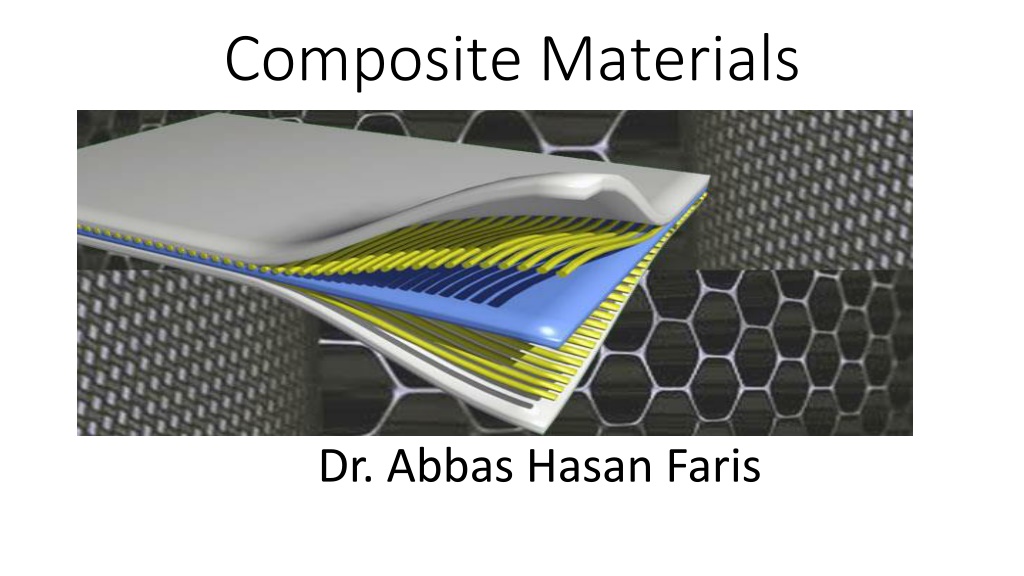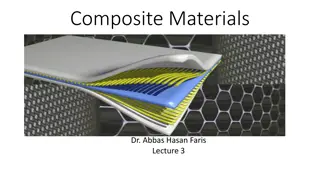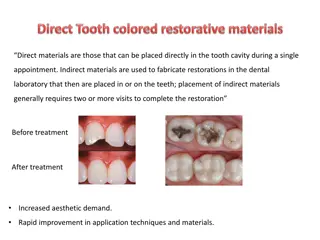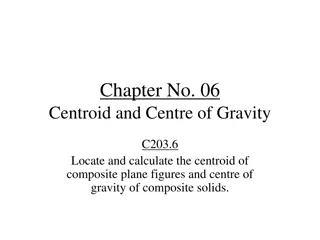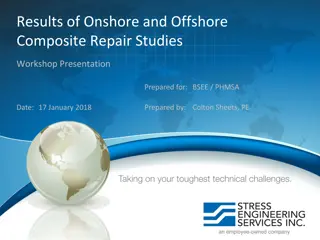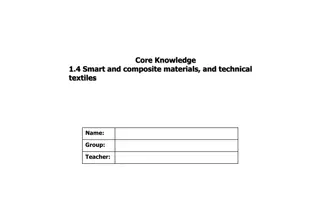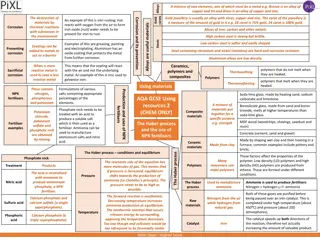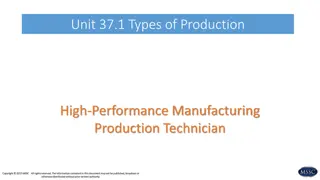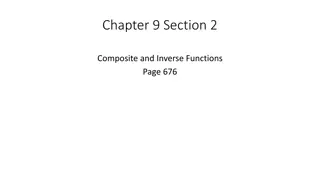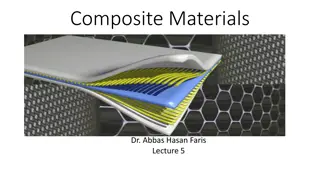Understanding Thermoset Composite Manufacturing Processes
Composite materials play a significant role in various industries, with thermoset composites dominating the market. The manufacturing processes for thermoset composites, such as hand lay-up and prepreg lay-up, are crucial in creating products like wind turbine blades and aerospace components. The hand lay-up process involves applying gel coat, placing fiberglass reinforcement, and applying resin before curing. This labor-intensive method offers advantages for producing prototype parts and small quantities.
Download Presentation

Please find below an Image/Link to download the presentation.
The content on the website is provided AS IS for your information and personal use only. It may not be sold, licensed, or shared on other websites without obtaining consent from the author. Download presentation by click this link. If you encounter any issues during the download, it is possible that the publisher has removed the file from their server.
E N D
Presentation Transcript
Composite Materials Dr. Abbas Hasan Faris
Composites Manufacturing Processes Composites manufacturing processes can be broadly subdivided into two main manufacturing categories: manufacturing processes for thermoset composites and manufacturing processes for thermoplastic composites. In terms of commercial applications, thermoset composite parts dominate the composite market. About 75% of all composite products are made from thermoset resins. Thermoset composite processes are much more mature than their thermoplastic counterparts mainly because of the widespread use of thermoset composites as well as their advantages over thermoplastic composite processing techniques. The first use of thermoset composites (glass fiber with unsaturated polyester) occurred in the early 1940s, whereas the use of thermoplastic composites came much later.
Manufacturing Processes for Thermoset Composites Hand lay-up process The hand lay-up process is mainly divided into two major methods: wet lay-up and prepreg lay-up. Hand lay-up, or contact molding, is the oldest and simplest way of making fiberglass resin composites. Applications are standard wind turbine blades, boats, etc.) 1. prepreg lay-up process is very common in the aerospace industry, It is also called the autoclave processing or vacuum bagging process. Complicated shapes with very high fiber volume fractions can be manufactured using this process. It is an open molding process with low- volume capability. In this process, prepregs are cut, laid down in the desired fiber orientation on a tool, and then vacuum bagged. After vacuum bagging, the composite with the mold is put inside an oven or autoclave and then heat and pressure are applied for curing and consolidation of the part. The prepreg lay-up or autoclave process is very labor intensive. Labor costs are 50 to 100 times greater than filament winding, pultrusion, and other high-volume processes; however, for building prototype parts and small quantity runs, the prepreg lay-up process provides advantages over other processes.
Hand lay-up process: * Gel coat is applied to open mold. (An even layer of resin, up to (0.5 mm) thickness is applied to the mould surface. This resin layer, known as the gel coat contains additives to give colour to the surface.) * Fiberglass reinforcement is placed in the mold. * Base resin mixed with catalysts is applied by pouring brushing or spraying..
The functions of the gel coat is to :- (i) Protect the fibers from external effects, mainly moisture penetration. (ii) Provide a smooth finish surface. when the gel coat is sufficiently cured , the first layer of fibers is placed on resin and used brush and roller to ensure the impregnation between the fibers and the matrix . It is used for boats and medium to large building
Spray-up process: This method is essentially similar to the hand lay-up method, but the reinforcement is usually chopped strands. The gel coat is applied to the mold, and then cured in a heated oven at 120 C. Continuous strand of fiber roving are fed into chopper gun and then the fibers along with catalyzed resin are fed through a chopper gun over the mould. Fibers are cut into lengths, varying from 20 to 60 mm. Fiber roving is fed continuously through a chopping unit. At the same time with resin by means of a spray gun. The mixture is then rolled to consolidate and remove any air that may be present in the composite It is used for:- 1. containers 2. automobile body parts
Handlay-up : ( ro htolc ; devomer morf dlom . fo , ( si ( ; ( 2 ( sreyal htiw niser si 1 ( ecafrus eht mrof denedrah edistuo si ni ylluf eht eht deruc ot , deilppa deilppa trap si niser rebif ria taoc dna evomer leg niht fo tnega tes esaeler yllaitrap eht rebif dlom taoc sah etangerpmi htiw leg detaert nehw dellor dlom gnidlom hcae reyal , ; ( 3 ( si tam si fo rebif ; ( 5 ( era ; ( 4 ( niser dna trap ot
1.1 Major Applications The prepreg lay-up process is widely used in the aerospace industry as well as for making prototype parts. Wing structures, radomes, yacht parts, and sporting goods are made using this process. Large glass/epoxy/honeycomb sandwich fairings for the Airbus 330/340 flap tracks. (Courtesy of Marion Composites.)
1.2 Basic Raw Materials 1.2.1. Thermoset Prepregs The most common resin used in thermoset prepreg materials is epoxy. Graphite/epoxy prepregs are the most commonly used materials for the prepreg lay-up process. Glass/epoxy and Kevlar/epoxy are also used but their use is much less than carbon/epoxy prepregs. The main reason is that carbon/epoxy is much lighter and stronger than other prepreg materials and provides greater mass savings in the component. Because this process is widely used in the aerospace industry, where weight is a critical design factor, carbon fiber prepreg is the material of choice. Moreover, in terms of cost, there is no significant price difference between carbon/epoxy prepregs and other prepregs. Other than epoxy, high-temperature resins such as polyimides, polycyanate, and bismaleimide (BMI) are also used in prepreg systems.
These prepregs are generally stored in a low-temperature environment and have a limited shelf life. Room-temperature prepregs are also becoming available. Usually, the resin is partially cured to a tack-free state called B- staging. Several additives (e.g., flame retardants, catalysts, and inhibitors) are added to meet various end-use properties and processing and handling needs. Thermoset prepregs require a longer process cycle time, typically in the range of 1 to 8 hr due to their slower kinetic reactions. Due to higher production needs, rapid-curing thermoset prepregs are being developed. Thermoset prepregs are more common and more widely used than thermoplastic prepregs. They are generally made by solvent impregnation and hot melt technology.
1.2.2 Thermoplastic Prepregs Thermoplastic prepregs have an unlimited shelf life at room temperature and are generally processed at the melting temperature of the resin. The most common resins are nylon, polyetheretherketone (PEEK), polyphe-nylene sulfide, polyimide, etc. The process cycle time for thermoplastic com-posites is much faster than thermoset composites, in the range of a few minutes. It is a relatively new technology and provides several processing and design advantages over thermoset prepregs. The benefits of thermoplas-tic prepregs are: Recyclability Good solvent and chemical resistance Reduced process cycle time Higher toughness and impact resistance Indefinite shelf life with no refrigeration Reshaping and reforming flexibility Greater flexibility for joining and assembly by fusion bonding and in situ consolidation Better repairability potential
The disadvantages of thermoplastic prepregs are that they require higher temperatures and pressures for processing. They provide some processing difficulties because of their poor drape capabilities. Thermoplastic prepregs are manufactured by solvent impregnation and hot melt coating techniques similar to thermoset prepreg manufacturing. Solvent impregnation becomes difficult because thermoplastics offer more chemical resistance.
Tooling Requirements The tooling for the prepreg lay-up process is an open mold on which prepregs are laid in the desired fiber orientation and sequence. For prototype building purposes, tools are made by machining metals, woods, and plastics. For the manufacture of aerospace components, the tooling material is mostly the composite tooling material such as carbon/epoxy prepregs. Making of the Part 1. The raw material for this process is prepreg material, which is kept refrigerated. To make the composite part, prepreg is removed from the refrigerator and brought slowly to room temperature. 2. Once the prepreg is brought to room temperature, it is cut to the desired length and shape. Predominantly unidirectional fiber prepregs are used for part fabrication. 3. Part fabrication is done by laying the prepregs on top of an open mold. Release agent is applied to the mold for easy removal of the part.
4. Vacuum bagging preparations are made as shown in Figure for curing and consolidation of the part. The steps required for vacuum bagging are: Apply release film, bleeder, barrier film, breather layer which allow entrapped air, excess resins, and volatiles to escape. Finaly, apply the vacuum bag, which is connected to a vacuum hose for creating vacuum inside the bag. Once the part is cured, the vacuum bag is removed and the part is taken out.
Methods of Applying Heat and Pressure After lamination and bagging, the mold is placed inside an autoclave for curing and consolidation. An autoclave, similar to a pressure vessel, can maintain the desired pressure and temperature inside the chamber for processing of the composite. A typical cure cycle is shown in Figure below.
1. The pressure is created in two ways: using the vacuum bag as well as the external pressure inside the autoclave. 2. To create vacuum inside the bag, the nozzle in the bagging system is connected to the vacuum pump using a hose. The vacuum pump generates the desired vacuum. External pressure inside the autoclave is created by injecting pressurized air or nitrogen. 3. the external pressure outside the bag and the vacuum inside the bag creates sufficient pressure to compact the laminate against the mold and create intimate contact between each laye. 4. The heat for curing comes from heated air or nitrogen. The pressurized gas supplied to the chamber comes heated to increase the temperature inside the autoclave. 5. As shown in Figure , vacuum is applied in the bagging system first and then the temperature is raised to a level to increase the resin flow. The heating rate is usually 2 C/min to 4 C/min. After dwelling for some time at the dwell temperature, the temperature is further raised to another level for curing of the composites. During this stage, pressure is applied to the outside of the bagging system and maintained for about 2 hr, depending on the requirements.
Therefore, one can calculate the heat transfer to the autoclave as: Q = Q t ? = ????? Where ? is the heat power, t is the time to increase the temperature of the autoclave by T = 1 C, Cp is the specific heat of autoclve material, and M is the mass of the autoclave. Example Calculate the time required to heat an autoclave made of welded steel by 1 C. The autoclave is cylindrical tube with volume 0.94 m3. The heater power supplied to the autoclve was 50 kW. Given that of steel is 7800 kg/m3 and Cp is 460 J/kg C.
Solution M = * V M = 7800 * 0.94 = 7,351 kg Q t = ????? t = ??? ??/ Q t = 7351 460 1/50 1000 = 67.6 ???????
Typical Manufacturing Challenges 1. Maintaining accurate fiber orientations in the part is difficult because prepregs are laid down by hand. 2. Obtaining void-free parts is a challenge during this process. Voids are caused by entrapped air between layers. 3. Achieving warpage- or distortion-free parts during the prepreg lay-up process is challenging. Warpage is caused by built-in residual stresses during processing.
Advantages of the Prepreg Lay-Up Process 1. It allows production of high fiber volume fraction (more than 60%) composite parts because of the use of prepregs. Prepregs usually have more than 60% fiber volume fraction. 2. Simple to complex parts can be easily manufactured using this process. 3. This process is very suitable for making prototype parts. It has the advantage of low tooling cost but the process requires high capital investment for the autoclave. 4. Very strong and stiff parts can be fabricated using this process. Limitations of the Prepreg Lay-Up Process 1. It is very labor intensive and is not suitable for high-volume pro duction applications. 2. The parts produced by the prepreg lay-up process are expensive.
